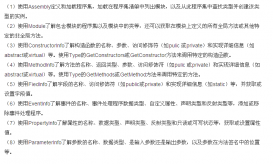Ajax技术显著加快了Web应用程序的速度。另外,视觉效果方面也有提升。大家都同意,每次点击按钮时整个页面都会被刷新这一点不太友好。如果你的网速不是很快,那么这个过程会很烦人,因为所有的元素都会先消失,再慢慢重新出现。如果只刷新一部分页面,那就美滋滋了。而这正是Ajax所提供的。该脚本向服务器发送一个请求,以更新所需的部分信息。然后,脚本将更新的数据插入页面上的正确位置。
在这个页面中,我想用一个简单的方法通过Ajax更新ASP .Net MVC项目中的信息。这种方法被称为“unobtrusive Ajax” - Microsoft Unobtrusive Ajax。其底线是使用Unobtrusive库,并且,辅助程序允许你使用Ajax而无需编写任何JavaScript代码。这个例子会非常简单,适合初学者。那么,我们开始吧。
要在一个MVC项目中使用FastReport.Net报表生成器自带的WebReport组件,你需要调整一些配置。即,编辑Web.Config文件并添加必要的库。
将FastReport和FastReport.Web库添加到你的项目中。
在Web.config中添加处理句柄,它位于项目的根目录中:
|
1
2
3
4
5
|
<system.webServer> <handlers> <add name="FastReportHandler" path="FastReport.Export.axd" verb="*" type="FastReport.Web.Handlers.WebExport"/> </handlers> </system.webServer> |
在位于Views文件夹中的Web.config文件中添加命名空间。
|
1
2
3
4
|
<namespaces> <add namespace="FastReport" /> <add namespace="FastReport.Web" /> </namespaces> |
在_Layout.cshtml文件的<head>部分添加脚本和样式:
|
1
2
3
4
|
<head> @WebReportGlobals.Scripts() @WebReportGlobals.Styles() </head> |
现在我们切换到HomeController.cs。在这里,我们放置业务逻辑:
我已经创建了全局报表对象:
|
1
2
3
4
5
6
7
8
9
10
11
12
13
14
15
16
17
18
19
20
21
22
23
24
25
26
27
28
29
30
31
|
using System; using System.Collections.Generic; using System.Linq; using System.Web; using System.Web.Mvc; using FastReport.Web; using System.Web.UI.WebControls; using System.Globalization; using WebLocalization.Models; namespace WebLocalization.Controllers { public class HomeController : Controller { private WebReport webReport = new WebReport(); // report object is available within the class private string report_path = "J:\\Program Files (x86)\\FastReports\\FastReport.Net\\Demos\\Reports\\"; //reports folder public ActionResult Index() { SetReport(); //method of loading report and DB ViewBag.WebReport = webReport; //pass the Web Report into the View return View(); } public void SetReport() { System.Data.DataSet dataSet = new System.Data.DataSet(); //create data set dataSet.ReadXml(report_path + "nwind.xml"); //Load xml database webReport.Report.RegisterData(dataSet, "NorthWind"); // register the data source in the report object webReport.Report.Load(report_path + "Simple Interactive.frx"); //load the report into WebReport object webReport.Width = Unit.Percentage(100); webReport.Height = Unit.Percentage(100); } |
如你所见,Index方法只包含了报表的加载,并通过ViewBag将其传递给视图。我将报表上传到单独的 SetReport() 方法。
现在考虑Index.cshtml的视图:
|
1
2
3
4
5
6
7
8
9
10
11
12
13
14
15
16
17
18
19
20
21
22
|
<script src="http://ajax.aspnetcdn.com/ajax/jquery/jquery-2.1.4.min.js"></script> <script src="http://ajax.aspnetcdn.com/ajax/jquery.migrate/jquery-migrate-1.2.1.min.js"></script> <script src="http://ajax.aspnetcdn.com/ajax/jquery.validate/1.13.1/jquery.validate.min.js"></script> <script src="http://ajax.aspnetcdn.com/ajax/mvc/5.2.2/jquery.validate.unobtrusive.min.js"></script> <script src="http://ajax.aspnetcdn.com/ajax/mvc/3.0/jquery.unobtrusive-ajax.min.js"></script> @{ ViewBag.Title = "Home Page"; } @using (Ajax.BeginForm("Update", "Home", new AjaxOptions { UpdateTargetId = "UpdateHere" //HttpMethod = "POST", //InsertionMode = InsertionMode.Replace, })) { @Html.CheckBox("condition", true) <input id="sel" type="submit" value="Select" /> } <div id="UpdateHere"> @ViewBag.WebReport.GetHtml() </div> </div> |
在开始的时候,我决定从官网上源 https://www.asp.net/ajax/cdn 下载必要的库。但是你也可以使用NuGet包安装库。
最有趣的是助手Ajax.BeginForm()。前两个参数表示动作(方法)和控制器。更新方法将在稍后创建。这个助手与 Html.BeginForm() 非常相似。只多加了一个参数 - "AjaxOptions"。你可以在MSDN中阅读有关这些选项的更多信息。其中最重要的是UpdateTargetId。正如你所理解的,它指示了要显示更改的元素的标识符。在我们的例子中,是<div id="UpdateHere"> 。但 @ ViewBag.WebReport.GetHtml() 元素已经显示在其中。这样做是为了在页面首次加载时从Index方法显示报表。
我在助手中显示复选框和按钮。该复选框将指示报表工具栏的状态 - 启用/禁用。
让我们回到控制器:
|
1
2
3
4
5
6
7
|
public ActionResult Index(string condition) { SetReport(); ToolbarCondition(condition); ViewBag.WebReport = webReport; return View(); } |
在Index方法中,我们传递条件参数 - 视图中复选框的状态。此外,它还添加了一个调用ToolbarCondition方法(条件)。它将处理参数并启用或禁用报表工具栏。我们来写这个方法:
|
1
2
3
4
5
6
7
|
public void ToolbarCondition(string condition) { if (condition=="true") webReport.ShowToolbar = true; else webReport.ShowToolbar = false; } |
现在,添加另一个将返回分部视图的方法。这要求Ajax请求仅更新页面的一部分,而不是整个页面:
|
1
2
3
4
5
6
7
8
|
[HttpPost] public ActionResult Update(string condition) { SetReport(); ToolbarCondition(condition); ViewBag.WebReport = webReport; return PartialView("Update"); } |
[HttpPost] 行表示该方法接受Post请求。我们的行动需要一个参数条件,以及索引。实际上,一切都是重复的,但最终我们得到了将被插入视图索引的分部视图。现在我们需要添加这个视图。
右键点击方法名称:
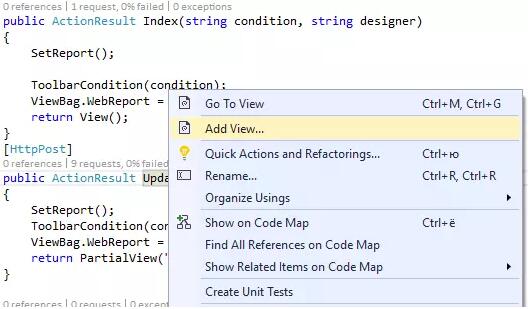
然后选择“添加视图...”:
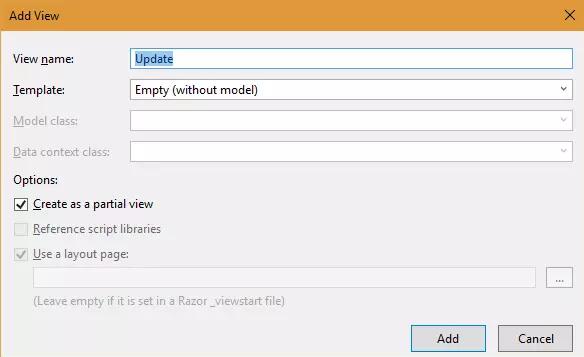
添加一个新的视图。让我们编辑它:
|
1
|
@ViewBag.WebReport.GetHtml() |
这就是我所有的代码。
你可以运行该应用程序:
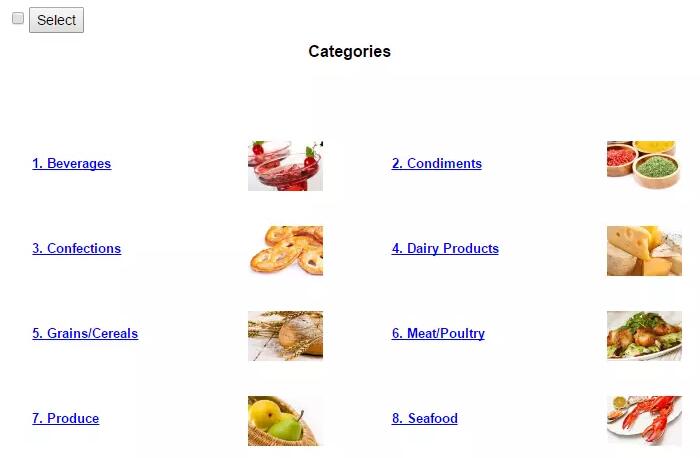
打开复选框并点击按钮:
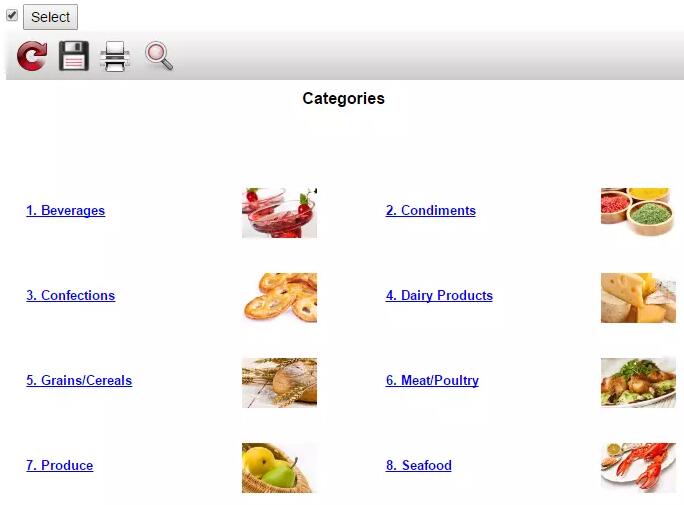
在这种情况下,只有WebReport对象被更新,而不是整个页面。当页面上有很多信息,且完全刷新会占用过多的时间和资源成本,这就很有用了。
以上这篇使用Ajax更新ASP.Net MVC项目中的报表对象方法就是小编分享给大家的全部内容了,希望能给大家一个参考,也希望大家多多支持服务器之家。
原文链接:http://blog.csdn.net/Pokemogo/article/details/79097115


